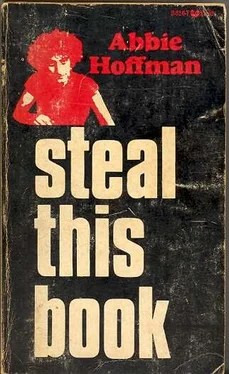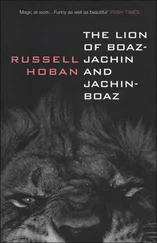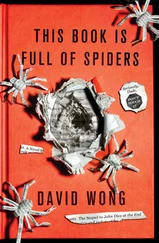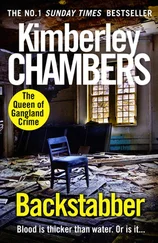Random violence produces random propaganda results. Why waste even a rock?
When you know there is going to be a rough street scene developing, don’t play into the pig’s strategy. Spread the action out. Help waste the enemy’s numbers.
You and the other members of your group should already have a target or two in mind that will make for easy trashing. If you don’t have one, setting fires in trash cans and ringing fire alarms will help provide a cover for other teams that do have objectives picked out. Putting out street lights with rocks also helps the general infusion.
After a few tries at trashing, you’ll begin to overcome your fears, learn what to expect from both the pigs and your comrades, and develop your own street strategy. Nothing works like practice in actual street conditions. Get your head together and you’ll become a pro. Don’t make the basic mistake of just naively floating into the area. Don’t think “rally” or “demonstration,” think “WAR” and “Battle Zone.” Keep your eyes and ears open. Watch for mistakes made by members of your gang and those made by other comrades. Watch for blunders by the police. In street fighting, every soldier should think like a general.
Workshops should be organized right after an action to discuss the strength and weaknesses of techniques and strategies used. Avoid political bullshit at such raps. Regard them as military sessions. Persons not versed in the tactics of revolution usually have nothing worthwhile to say about the politics of revolution.
You can purchase buteric acid at any chemical supply store for “laboratory experiments.” It can be thrown or poured directly in an area you think already stinks. A small bottle can be left uncapped behind a door that opens into the target room. When a person enters they will knock over the bottle, spilling the liquid. Called a “Froines,” by those in the know, an ounce of buteric acid can go a long way. Be careful not to get it on your clothing. A home-made stink bomb can be made by mixing a batch of egg whites, Drano, (sodium hydroxide) and water.
Let the mixture sit for a few days in a capped bottle before using.
Sometimes it becomes strategically correct to confuse the opposition and provide a smoke screen to aid an escape. A real home-made stroke bomb can be made by combining four parts sugar to six parts saltpeter (available at all chemical supply stores). This mixture must then be heated over a very low flame. It will blend into a plastic substance. When this starts to gel, remove from the heat and allow the plastic to cool. Embed a few wooden match heads into the mass while it’s still pliable and attach a fuse. [3] You can make a good homemade fuse by dipping a string in glue and then rolling it lightly in gunpowder. When the glue hardens, wrap the string tightly and neatly with scotch tape. This fuse can be used in a variety of ways. Weight it on one end and drop a rock into the tank of a pig vehicle. Light the other end and run like hell.
The smoke bomb itself is a non-explosive and non-flame-producing, so no extreme safety requirements are needed. About a pound of the plastic will produce thick enough smoke to fill a city block. Just make sure you know which way the wind is blowing. Weathermen-women! If you’re not the domestic type, you can order smoke flares (yellow or black) for $2.00 a flare [12 inch] from Time Square Stage Lighting Co., 318 West 47th Street, New York, NY 10036.
LACE (Lysergic Acid Crypto-Ethelene) can be made by mixing LSD with DMSO, a high penetrating agent, and water. Sprayed from an atomizer or squirted from a water pistol, the purple liquid will send any pig twirling into the Never-Never Land of chromosome damage. It produces an involuntary pelvic action in cops that resembles fucking. Remember when Mace runs out, turn to Lace.
How about coating thin darts in LSD and shooting them from a Daisy Air Pellet Gun? Guns and darts are available at hobby and sports shops. Sharpening the otherwise dull darts will help in turning on your prey.
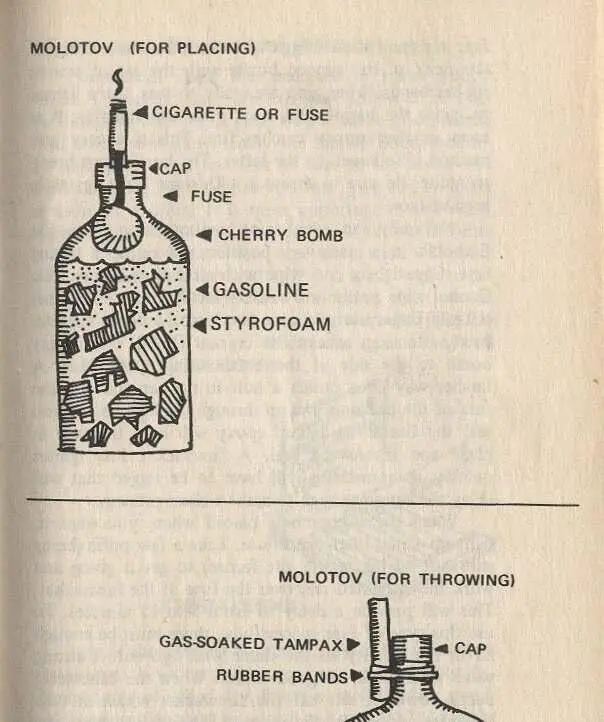
Molotov cocktails are a classic street fighting weapon served up around the world. If you’ve never made one, you should try it the next time you are in some out-of-the-way barren place just to wipe the fear out of your mind and know that it works. Fill a thin-walled bottle half full with gasoline. Break up a section of styrofoam (cups made of this substance work fine) and let it sit in the gasoline for a few days. The mixture should be slushy and almost fill the bottle. The styrofoam spreads the flames around and regulates the burning. The mixture has nearly the same properties as napalm. Soap flakes (not detergents) can be substituted for styrofoam. Rubber cement and sterno also work. In a pinch, plain gasoline will do nicely, but it burns very fast. A gasoline-kerosene mixture is preferred by some folks.
Throwing, although by far not the safest method, is sometimes necessary. The classic technique of stuffing a rag in the neck of a bottle, lighting and tossing is foolish. Often gas fumes escape from the bottle and the mixture ignites too soon, endangering the thrower. If you’re into throwing, the following is a much safer method: Once the mixture is prepared and inside the bottle, cap it tightly using the original cap or a suitable cork. Then wash the bottle off with rubbing alcohol and wipe it clean. Just before you leave to strike a target, take a strip of rag or a tampax and dip it in gasoline. Wrap this fuse in a small plastic baggie and attach the whole thing to the neck of the capped bottle with the aid of several rubber bands. When you are ready to toss, use a lighter to ignite the baggie. Pall back your arm and fling it as soon as the tampax catches fire. This is a very safe method if followed to the letter. The bottle must break to ignite. Be sure to throw it with some force against a hard surface.
Naturally, an even safer method is to place the firebomb in a stationary position and rig up a timing fuse. Cap tightly and wipe with alcohol as before. The alcohol wipe not only is a safety factor, but it eliminates tell-tale fingerprints in case the Molotov doesn’t ignite. Next, attach an ashcan fire cracker (M-80) or a cherry bomb to the side of the bottle using epoxy glue. A fancier way is to punch a hole in the cap and pull the fuse of the cherry bomb up through the hole before you seal the bottle. A dab of epoxy will hold the fuse in place and insure the seal. A firecracker fuse ignites quickly so something will have to be rigged that will deal the action enough to make a clean getaway.
When the firebomb is placed where you want it, light up a non-filter cancerette.
Take a few puffs (being sure not to inhale the vile fumes) to get it going and work the unlighted end over the fuse of the firecracker. This will provide a delay of from 5 to 15 minutes. To use this type of fuse successfully, there must be enough air in the vicinity so the flame won’t go out. A strong wind would not be good either. When the cancerette burns down, it sets off the firecracker which in turn explodes and ignites the mixture. The flames shoot out in the direction opposite to where you attach the firecracker, thus allowing you to aim the firebomb at the most flammable material. With the firecracker in the cap, the flames spread downward in a halo. The cancerette fuse can also be used with a book of matches to ignite a pool of gasoline or a trash can. Stick the unlighted end behind the row of match heads and close the cover. A firecracker attached to a gallon jug of red paint and set off can turn an office into total abstract art.
Читать дальше
